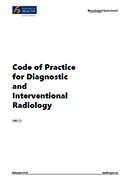
This Code of Practice for Diagnostic and Interventional Radiology is issued by the Director for Radiation Safety under section 86 of the Radiation Safety Act 2016. It provides details necessary to comply with the fundamental requirements in sections 9 to 12 of the Act. Appendix 1 sets out cross-references between clauses in the code and those fundamental requirements. The requirements in this code do not limit the general nature of the fundamental requirements.
This code came into force on 9 November 2018.
Scope
This code applies to all activities associated with radiological equipment used for diagnostic radiology, interventional radiology, the dental use of cone beam computed tomography equipment and research. Activities can include manufacturing, possessing, controlling, managing, using, transporting, storing, importing, exporting, selling, supplying and disposing of equipment.
Compliance with the code does not imply compliance in related areas such as health practitioner clinical competence, occupational safety, hazards in the workplace, resource management and transport of hazardous substances.
Background
Under the old Radiation Protection Act 1965 all radiologists were required to hold a user licence and, as a condition of that licence, were required to comply with the code of safe practice CSP5. Under the new Radiation Safety Act 2016 the Director is authorised to issue codes of practice that apply to everyone who deals with radiation sources irrespective of whether or not they are licensed. The new code therefore applies to all radiologists, other health practitioners who use X-ray equipment for diagnostic or interventional purposes, medical physicists and the organisations that manage or control radiation sources used for these purposes.
Consultation process
In September 2016 the Ministry released a document for public consultation. This was notified widely including to all health practitioners who held licences under the old Act. 178 individual submissions were received from 12 individuals or organisations that were specific to the radiology code.
In addition the Ministry has consulted on other codes relating to dental radiography, medical therapy, nuclear medicine and non-medical uses of radiation sources. The Ministry is mindful of the need to consistency across all codes and has therefore taken account of submissions made for all codes in order to develop final consistent documents.
Changes
The main change under the new Act relates to imposing the prime responsibility for radiation protection and safety on the organisation that manages or controls radiation sources. The previous Act only allowed for the licensing of individual users. The new code confirms this change in prime responsibility and sets out the requirements that organisations must satisfy.
Requirements are also imposed on health practitioners relating to the justification and optimisation of diagnostic and interventional procedures and on suppliers and servicing engineers. In all cases these are consistent with international recommendations. The code establishes two sets out prescriptive requirements for radiological and ancillary equipment – one to be met in all cases and another to be aspired to in order to satisfy the optimisation principle.
The code also establishes specific training requirements that have been derived from recommendations of the International Commission on Radiological Protection. Training is an important regulatory priority and the establishment of these requirements is a critical first step in setting up a comprehensive training programme.
What this means for practice
District health boards and private radiology providers will need to redistribute functions between the owner and practitioners in order to meet international requirements that are reflected in the new code. This will require a reassessment of roles but the Ministry is aware that these discussions have been taking place for some time now.
What about guidance notes?
The previous code contained a mixture of ‘shalls’ and ‘shoulds’ to distinguish between regulatory requirements that must be complied with and recommendations that are not mandatory. The new Act specifies that the codes set out requirements that must be complied with. The Ministry will therefore work on a separate guidance document to assist practitioners and organisations to understand and comply with the new requirements. This work can commence when codes of practice for all other areas of radiation use have been issued.
